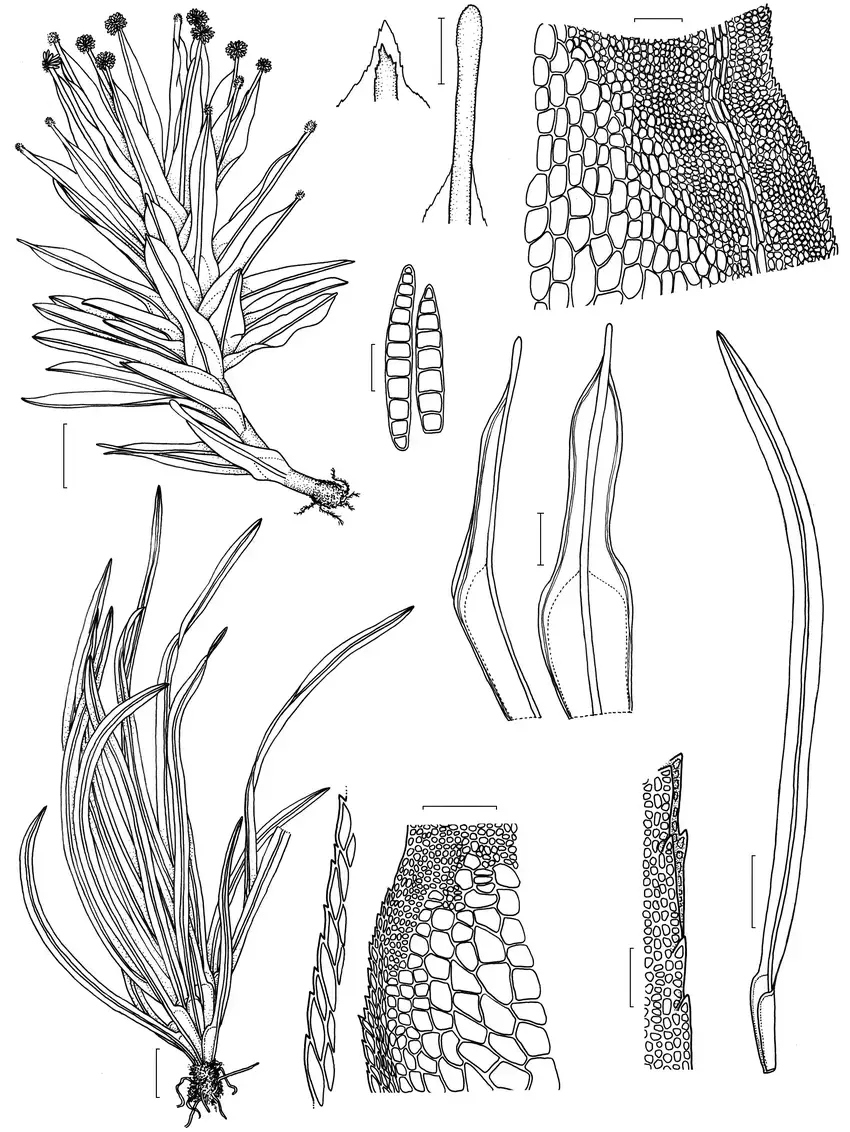
a-e-Calymperes-erosum-a-habit-b-leaf-apex-c-cells-at-leaf-shoulder-d-gemmae-e.png from: https://www.researchgate.net/figure/a-e-Calymperes-erosum-a-habit-b-leaf-apex-c-cells-at-leaf-shoulder-d-gemmae-e_fig1_327378070
Introduction
In the vast and captivating world of bryophytes, the Calymperes erosum Müll.Hal. moss stands out as a remarkable species within the Calymperaceae family. Often referred to simply as Calymperes, this unassuming yet fascinating moss has captured the interest of enthusiasts and researchers alike. Let’s delve into the intriguing realm of this diminutive plant and uncover its secrets.
Background

pc0148350.jpg from: https://plants.jstor.org/stable/10.5555/al.ap.specimen.pc0148350
Before we explore the specifics of Calymperes erosum, it’s essential to understand the broader context of bryophytes. These non-vascular plants, which include mosses, liverworts, and hornworts, are among the oldest land plants on Earth. They play crucial roles in various ecosystems, acting as pioneers in colonizing new environments and contributing to soil formation and moisture retention.

img-z8-2_101.jpg from: https://bioone.org/journals/annales-botanici-fennici/volume-58/issue-1-3/085.058.0116/Bryophytes-of-Hồ-Chí-Minh-City-Vietnam/10.5735/085.058.0116.full
Main Content
Morphology and Identification
Calymperes erosum is a small, acrocarpous moss that forms dense, cushion-like tufts or mats. Its leaves are ovate-lanceolate, with a distinctive eroded or toothed apex, giving rise to its specific epithet “erosum.” The leaves are typically spirally twisted when dry, a characteristic that aids in water retention. The calyptra (a protective cap covering the developing sporophyte) is cucullate (hood-shaped) and hairy.
Global Distribution and Habitat
This moss species has a widespread distribution, occurring in various regions across the globe, including tropical and subtropical areas. It can be found growing on tree bark, rocks, and soil in humid forests, often preferring shaded and moist environments. Calymperes erosum is particularly abundant in regions with high humidity and rainfall, such as tropical rainforests.
Ecological Roles and Adaptations
Like many bryophytes, Calymperes erosum plays a vital role in its ecosystem. It contributes to soil formation and moisture retention, creating favorable conditions for other plants to thrive. Additionally, this moss serves as a microhabitat for various invertebrates, providing shelter and food sources.
One of the remarkable adaptations of Calymperes erosum is its ability to tolerate desiccation. During dry periods, the moss can enter a state of dormancy, reviving once moisture becomes available again. This resilience allows it to survive in environments with fluctuating moisture levels.
Case Studies/Examples
In a study conducted in the Brazilian Atlantic Forest, researchers found Calymperes erosum to be a significant component of the epiphytic bryophyte community. Its presence on tree trunks and branches contributed to the overall biodiversity and ecosystem functioning of the forest.
Another example comes from Southeast Asia, where Calymperes erosum is commonly found in tropical peat swamp forests. These unique ecosystems are characterized by waterlogged, acidic conditions, and the moss plays a crucial role in maintaining the delicate balance of the environment.

f01_317.jpg from: https://bioone.org/journals/candollea/volume-66/issue-2/c2011v662a8/Type-Specimens-of-Taxa-Described-by-C-F-Schwägrichen-in/10.15553/c2011v662a8.full
Technical Table

5856d54f21c593d9017a4c708465902e.jpg from: https://taieol.tw/muse/digi_object/944be5363af1050246cc941b5ca41998
| Characteristic | Description |
|---|---|
| Phylum | Bryophyta |
| Class | Bryopsida
 5856d54f21c593d9017a4c708465902e.jpg from: https://openmuseum.tw/muse/digi_object/944be5363af1050246cc941b5ca41998 |
| Order | Leucodontales
 Moss_Gametophytes_Sporophytes.jpg from: https://www.botany.one/2017/01/moss-bringer-stability-life/ |
Family
 16083595bb6b5297d4932aee5f359826.jpg from: https://openmuseum.tw/muse/digi_object/2355523fe7d6b11d4b7a8ac495911fd7 |
Calymperaceae |
| Genus | Calymperes |
| Species | Calymperes erosum Müll.Hal. |
| Leaf Shape | Ovate-lanceolate, eroded apex |
| Calyptra | Cucullate, hairy |
| Habitat | Tree bark, rocks, soil in humid forests |
| Distribution | Tropical and subtropical regions worldwide |
Conclusion
The Calymperes erosum Müll.Hal. moss, a member of the Calymperaceae family, is a remarkable species that has captured the hearts of bryophyte enthusiasts worldwide. Its unique morphology, global distribution, and ecological roles make it a fascinating subject of study. As we continue to explore the intricate world of bryophytes, we are reminded of the incredible diversity and resilience of these ancient plants. Perhaps the next time you encounter a cushion-like mat of moss, you’ll pause and appreciate the wonders of Calymperes erosum.
Ponder this: In a world where we often overlook the smallest of creatures, what other hidden marvels might be waiting to be discovered, right beneath our feet?